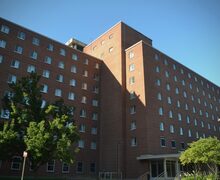SEUNA collects signatures to petition universities for more dorms
City residents near Syracuse University and the State University of New York College of Environmental Science and Forestry want less students living in their neighborhood.
The Southeast University Neighborhood Association has now collected 1,000 signatures on two petitions to SU, SUNY-ESF and the city of Syracuse, which ask the universities to build more on-campus housing and the city to change its zoning laws in a manner that will lower the population density of students living in the neighborhood, said Harry Lewis, the association’s treasurer and a resident of Livingston Avenue. SEUNA has been working on the petitions since October.
The first petition requests the city, SU and SUNY-ESF to develop more housing for undergraduate students, with a five-year goal of being able to house 90 percent of undergraduates in university housing.
The second petition asks the city to amend a 1991 law that limited the number of unrelated adults living together to five. SEUNA requests that figure be changed to three.
SEUNA, a 34-year-old volunteer organization of homeowners in the area bounded by Westmoreland Avenue, Clarendon Street, Ostrom Avenue, Comstock Avenue and East Colvin Street, spent much of the late summer and fall of 2005 going door to door with the two petitions, Lewis said.
There are about 500 signatures on each petition right now, but only about 500 names total between the two, Lewis said, but SEUNA plans on trying to get more signatures in the spring.
An increase in population density in the area has led to a decrease in the value of residential homes, Lewis said, and a lower number of students in each house translates into better property maintenance. He also said parties and noise are an issue.
‘When I get up to go to church early Sunday morning, I can tell where the parties have been,’ Lewis said. ‘Red cups are all over the place, a pong table is still out and maybe a couple of chairs are broken.’
Other issues include cars parked in the streets or in front yards because most houses only have a one-car garage and the driveways may not be long enough for each tenant’s car, Lewis said.
Ben Tupper, a landlord with about 300 SU students as tenants in the neighborhood, said the petitions come from the illusion that students are rowdier than they have been in the past.
‘I would have 95 percent of my tenants as neighbors in a heartbeat,’ Tupper said.
Tupper also said that if the number of tenants allowed in each house is decreased, students will only be forced further from campus, and rent per person may increase.
Living off campus is a learning experience in gaining responsibility from having to pay bills to utilities and landlords, Tupper said.
Lewis also said that living off campus is a part of growing up. However, the first petition cites the American Council on Education, which found that students living in university-sponsored housing tend to get better grades and are more likely to obtain their diplomas than students living in non-university housing.
‘The idea is kind of silly,’ said Katie O’Rourke, a junior biology major who lives on Euclid Avenue. ‘They could never get normal people to live in the college housing. It’ll just be a whole lot of vacant houses.’
Molly Lawenda, a third-year architecture major, also of Euclid Avenue, said the houses are too large to limit the amount of people living in them. Her house has seven bedrooms, but there are five people on the lease, Lawenda said.
‘Students today are 100 percent better than they were 10 years ago,’ Lewis said. When asked why SEUNA is taking action now, he responded, ‘Who knows?’
Published on February 21, 2006 at 12:00 pm





